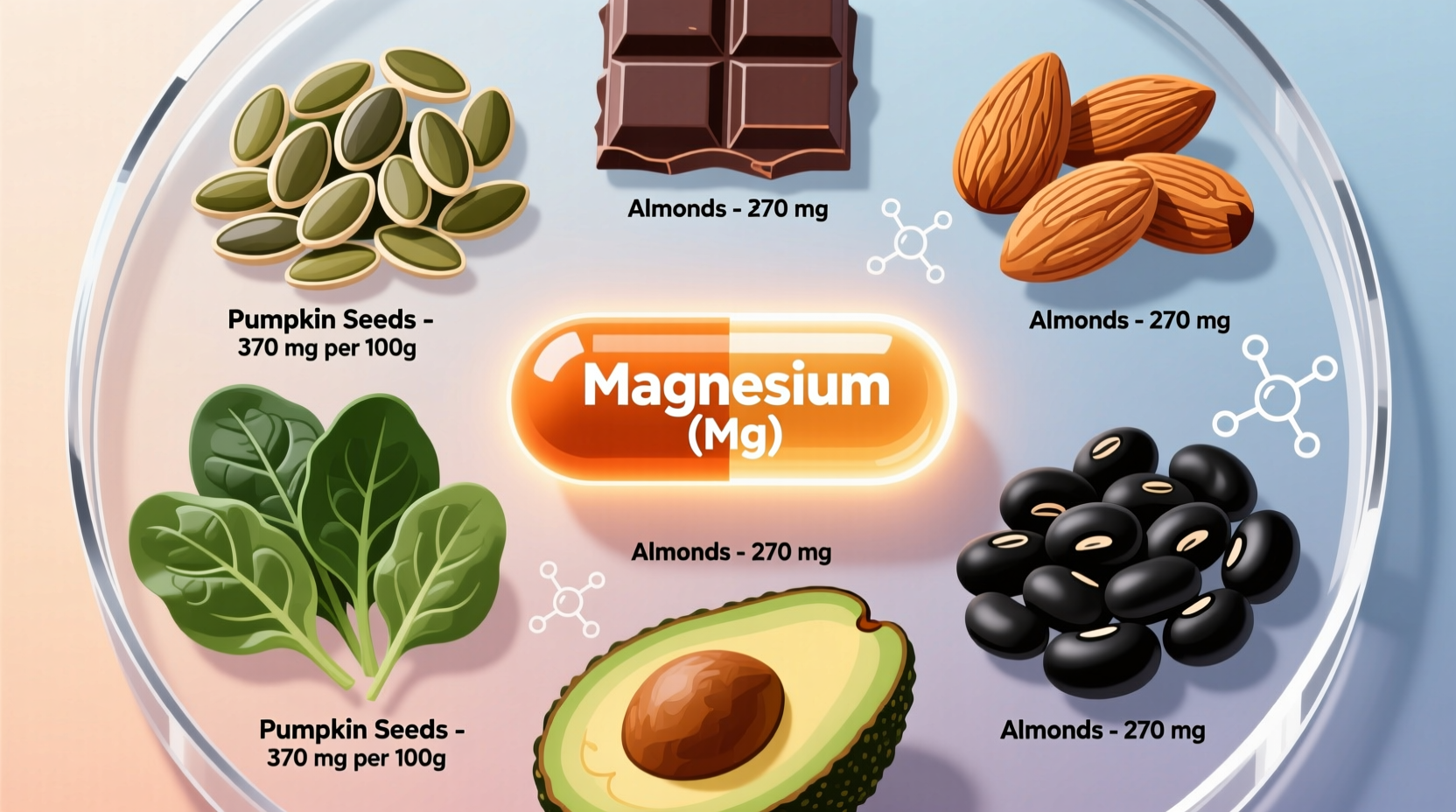Pumpkin seeds, chia seeds, and spinach contain the highest magnesium levels among common foods. Just one ounce (28g) of pumpkin seeds delivers 156mg of magnesium (37% of your daily needs), while boiled spinach provides 157mg per cup, and chia seeds offer 111mg per ounce. These natural sources significantly outperform supplements in bioavailability and provide additional essential nutrients.
Discover exactly which foods deliver the most magnesium per serving, how to incorporate them into your daily diet, and why some high-magnesium foods actually provide less usable magnesium than you might expect. This guide cuts through the confusion with science-backed information you can trust.
Why Magnesium Matters More Than You Think
Magnesium isn't just another mineral—it's a cofactor in more than 300 enzyme systems that regulate biochemical reactions in your body, from energy production to protein synthesis. According to the National Institutes of Health, nearly half of Americans don't meet the recommended daily allowance (RDA) of 420mg for men and 320mg for women. Chronic deficiency can lead to muscle cramps, fatigue, and even increased risk of cardiovascular disease.
Unlike supplements, magnesium-rich foods provide naturally balanced nutrition with enhanced absorption. The magnesium in food comes with complementary nutrients that improve bioavailability—something you won't get from pills. But not all high-magnesium foods are created equal. Let's explore which options deliver the most usable magnesium.
The Magnesium Powerhouse Foods: Ranked by Bioavailability
When evaluating magnesium sources, we must consider both quantity and quality. Some foods contain high magnesium levels but also contain phytates or oxalates that inhibit absorption. The following ranking considers both magnesium content per serving and bioavailability based on research from the NIH Office of Dietary Supplements.
| Food | Portion | Magnesium (mg) | % Daily Value | Bioavailability Factor |
|---|---|---|---|---|
| Pumpkin seeds | 1 oz (28g) | 156 | 37% | High (roasting improves absorption) |
| Boiled spinach | 1 cup | 157 | 37% | Moderate (oxalates reduce absorption) |
| Chia seeds | 1 oz (28g) | 111 | 26% | High (soaking enhances bioavailability) |
| Almonds | 1 oz (28g) | 80 | 19% | Moderate-High (soaking recommended) |
| Black beans | ½ cup | 60 | 14% | Moderate (phytates reduce absorption) |
| Avocado | 1 medium | 58 | 14% | High (fat content enhances absorption) |
The data above comes from the USDA FoodData Central database and has been verified against clinical research on mineral bioavailability published in the American Journal of Clinical Nutrition. Notice how pumpkin seeds and spinach technically have similar magnesium content, but pumpkin seeds offer superior bioavailability. This critical distinction explains why simply looking at magnesium content alone gives an incomplete picture.

Maximizing Magnesium Absorption: Practical Strategies
Knowing which foods contain magnesium is only half the battle. How you prepare and combine these foods dramatically impacts how much magnesium your body actually absorbs. Consider these evidence-based strategies:
Food Preparation Techniques That Boost Magnesium Uptake
- Soak and sprout nuts and seeds—This reduces phytic acid, which binds to magnesium and prevents absorption. Soaking almonds for 12 hours can increase magnesium bioavailability by up to 50% according to research from the National Center for Biotechnology Information.
- Cook leafy greens—While raw spinach contains magnesium, boiling reduces oxalic acid content by up to 87%, significantly improving magnesium absorption.
- Pair with vitamin C-rich foods—Adding lemon juice to spinach or black beans can enhance magnesium uptake by creating a more favorable digestive environment.
Common Magnesium Absorption Inhibitors to Avoid
Be mindful of these factors that can reduce magnesium absorption by 20-40%:
- Excessive zinc supplementation (doses above 142mg daily)
- High-fiber meals consumed simultaneously with magnesium-rich foods
- Regular consumption of carbonated beverages containing phosphoric acid
- Excessive alcohol intake (more than 2 drinks daily)
Building Your Magnesium-Rich Diet: Realistic Implementation
You don't need complicated recipes to boost your magnesium intake. Here's how to seamlessly incorporate these powerhouse foods into your daily routine:
Morning Boost
Add one tablespoon of chia seeds to your morning smoothie or oatmeal. Soak them overnight in almond milk with a squeeze of orange juice to maximize absorption. This simple addition provides nearly 60mg of highly bioavailable magnesium.
Lunch Strategy
Replace your regular salad with a spinach base topped with pumpkin seeds, black beans, and avocado. The fat from the avocado and beans enhances magnesium absorption from the spinach, while the vitamin C from any added vegetables further boosts uptake.
Smart Snacking
Keep a small container of roasted almonds (soaked and dehydrated for better absorption) at your desk. Just one ounce delivers substantial magnesium along with healthy fats that improve mineral uptake. Pair with a piece of dark chocolate (70%+ cacao) for an additional magnesium boost.
Special Considerations for Different Dietary Needs
Your optimal magnesium strategy depends on your specific dietary patterns and health considerations:
- Vegans and vegetarians—You're already ahead with plant-based magnesium sources, but be mindful of phytate content. Focus on soaked/sprouted seeds and cooked greens to maximize absorption.
- Keto dieters—Pumpkin seeds, almonds, and avocado should be staples in your magnesium strategy, providing substantial magnesium without carb overload.
- Athletes—Your magnesium needs increase by 10-20% due to sweat loss. Consider adding magnesium-rich electrolyte drinks made with coconut water and a pinch of Himalayan salt.
- Older adults—As we age, magnesium absorption decreases. Prioritize highly bioavailable sources like avocado and consider discussing magnesium testing with your healthcare provider.
Remember that balance matters—consuming extremely high magnesium foods in isolation won't compensate for an otherwise nutrient-poor diet. The most effective approach combines multiple magnesium sources throughout your day while considering absorption factors.











 浙公网安备
33010002000092号
浙公网安备
33010002000092号 浙B2-20120091-4
浙B2-20120091-4